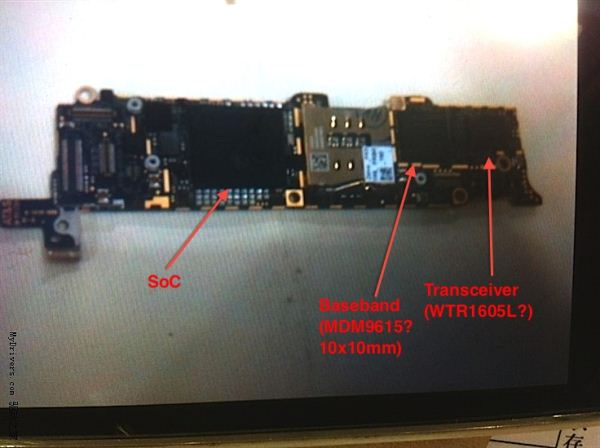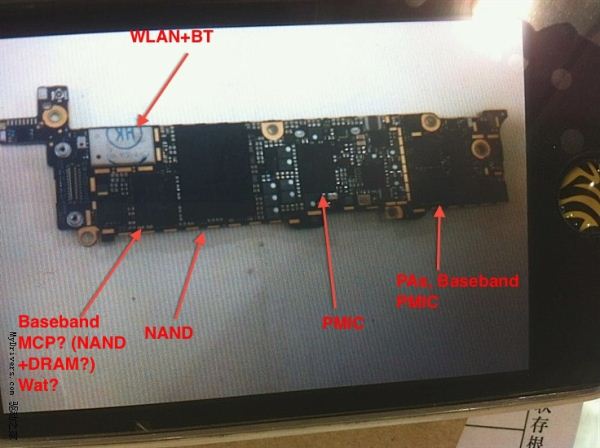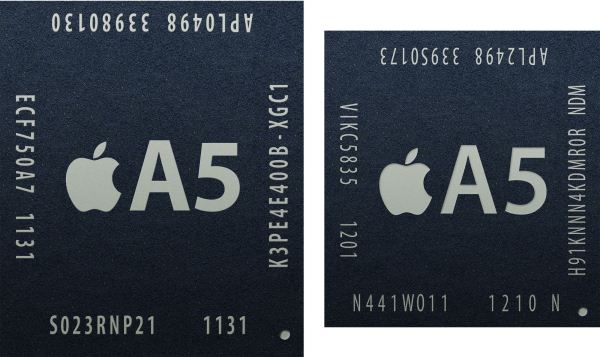Preparing for the iPhone Next: Rumors Analyzed
by Brian Klug & Anand Lal Shimpi on August 27, 2012 9:40 PM EST- Posted in
- Smartphones
- Apple
- Mobile
- iPhone
The SoC: 32nm A5R2?
So much of any new iPad/iPhone release is tied to the SoC. Apple remains one of the only handset designers that aggressively specs its own SoC rather than picking up an off the shelf part. As of late, Apple has used its control over its own SoC architecture to better match its chip architectures to the needs of its high resolution displays. Apple continues to produce its custom-designed SoCs at Samsung, although it's likely that Apple will consider other foundries at the 20nm node.


Rumored upcoming PCB, annotations ours
Most early looks at the next iPhone's internals show no silkscreened part numbers on the SoC. We've already seen blurry photos of the suspected upcoming PCB leak, though they're far too low quality to make out any chip markings. Given Apple's history, it's likely we'll see a 32nm LP (HK+MG) variant of the A5 SoC used in the iPhone 4S - perhaps at higher clocks. The move to a smaller process node should bring about a tangible increase in battery life. Depending on the workload, the iPhone 4S could burn more power than the iPhone 4 thanks to its beefy CPU + GPU combination. The move to 32nm could easily offset this penalty.
We've seen Apple experiment with Samsung's 32nm LP process in the past. Both the current generation Apple TV and the iPad 2,4 use a 32nm A5. In the case of the iPad 2,4, we saw a huge increase in battery life as a result of the move to 32nm. Some of the gains in battery life in the iPhone are likely to be offset by higher CPU/GPU clocks, but this is still the most likely approach for Apple this generation.

Original A5 (45nm, S5L8940, left), A5R2 (32nm, S5L8942, right)
As we mentioned back during our review of the iPad 2,4, it makes sense to test a new/unfamiliar process on a low volume part. By shipping 32nm A5 SoCs into some iPad 2s and the Apple TV (a hobby product), Apple could ride the 32nm yield curve up without adversely impacting shipments of its key money makers. With Samsung's 32nm LP process likely seeing much better yields now, it's time to deploy it in the next iPhone. Given much of the competition has moved to TSMC's 28nm process, Apple must remain competitive on the process node front as well. Shipping a 45nm SoC at the end of 2012 simply doesn't make sense. Although the current legal battles with Samsung could impact the relationship on the foundry side, simply switching to Global Foundries or TSMC is easier said than done. I would expect Apple to go through the same careful transition between Samsung and any other foundry as it did when it introduced the first 32nm A5s into the mix. The current expectations here are that we'll see Apple look at TSMC at the 20nm node.
With process node pretty much guaranteed, there's the question of CPU and GPU architectures.
Since the release of the original iPad, Apple has used the spring to introduce new SoC architectures in the iPad and later waterfall them down to the iPhone in the summer/fall. The A5X in the 3rd generation iPad however is still built on Samsung's 45nm LP process and is huge as a result of integrating four PowerVR SGX543 cores and implementing a 4 x 32-bit memory interface. The A5X needed the GPU power and memory bandwidth to drive the new iPad's retina display, but that power would be largely lost on the next iPhone.
The new iPhone is expected to have a 640 x 1136 resolution, thanks to its taller 4-inch display, but that's only 18% more pixels than the current iPhone 4S. A doubling of memory bandwidth and GPU compute horsepower would seem a bit excessive for current workloads. A ~20% increase in GPU clock speed, and faster DRAM would be enough to maintain current levels of performance on the higher resolution display.
Apple decoupled major cellular architecture and CPU architecture shifts in the past (e.g. iPhone 3G/3GS transition), which lends credibility to the idea of a move to A15 next year with the 4th gen iPad and sticking with the dual-core A9 design for the next iPhone. There's also the fact that TI is expected to be one of the first to bring an ARM Cortex A15 based SoC to market, and even it hasn't demonstrated an OMAP 5 running at shipping CPU clocks yet. I don't doubt that it's possible to ship an A15 based SoC before the end of the year, but based on the demos we've seen thus far, it seems highly unlikely to see one shipping in Q3. Apple doesn't like to be overly risky on the component front. There's nothing worse than a poorly yielding or otherwise problematic chip holding up shipments of one of your biggest revenue generators.










131 Comments
View All Comments
alxx - Tuesday, August 28, 2012 - link
or buy it to replace iphone 4 with starting to fade batteriesplext0r - Tuesday, August 28, 2012 - link
That's my dilemma. IPhone "Next" or SGS3. :) I currently have the iPhone 4.ltcommanderdata - Tuesday, August 28, 2012 - link
Hopefully Apple adopts a wide gamut IPS screen for the next gen iPhone as they've done for the 2012 iPad.It's too bad Apple's Q3 iPhone release schedule leaves them at an awkward time at the tail end of this silicon generation. Sticking to a 32nm A5, a 50% clock speed bump over the iPhone 4S to 1.2GHz seems reasonable and would be well positioned at launch. However, competition will come very quickly with Cortex A15 based CPUs and OpenGL ES 3.0 capable GPUs in Q4 and Q1 2013.
alxx - Tuesday, August 28, 2012 - link
In A15 chips are up to speed and ready in time.Has any A15 based chip been public-ally demoed over 1GHz yet ?
leomax999 - Tuesday, August 28, 2012 - link
Exynos 5250 in disguise at SIGGRAPH.krumme - Tuesday, August 28, 2012 - link
Iphone buyers dont buy specsExcept when Apple tells them to do
Therefore Apple can be as conservative and innovative as is needed in the market situation. No other company have that luxury.
Tegeril - Tuesday, August 28, 2012 - link
Sigh.doobydoo - Thursday, September 6, 2012 - link
The only reason iPhone buyers don't buy specs is that specs have never been an issue for iPhone users.That is to say, the software and apps have always run flawlessly on iOS.
The same can't be said for Android.
As for why this is the case? Look no further than the tight integration between hardware and software combined with, for example, the fact that the iPhone 4S has the fastest GPU in any smartphone in America.
rupaniii - Tuesday, August 28, 2012 - link
I'm guessing Power teaked version of the A15 core in Dual configuration, along with the top of the line PowerVR in Dual GPU configuration. It's got to be a world beater. Definitely worldwide LTE locked at carrier level.If not, Snapdragon S4Pro will own it.
A5 - Tuesday, August 28, 2012 - link
None of those designs (A15 or PowerVR 6-series) are ready yet. Apple has never been one to fight the spec war, and I don't see any of that changing now.